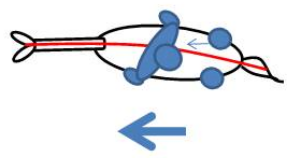Quarters in, what is it and how do we do it? Here are my best tips on how to ride quarters in for the beginner, intermediate and advanced rider.
In quarters in, the hindlegs of the horse are stepping inside of the track of a bent horse. It is also called travers and haunches in. While we are teaching the inside hindleg to step in under the point of weight in shoulder in, we teach the outside hindleg to step in under the point of weight in the quarters in.

Quarters in for the beginner
Just like for shoulder in, the horse must have a basic understanding of leg and rein aids. If the horse does not understand these aids, they are easier to teach from the ground. Here you can find some tips on how to do it.
For the rider the quarters in is often easier done on a straight line, whereas for the horse it is easier on circle, as the circle helps the horse with the bending. An easy start for the quarters in is to ride a circle in the corner and move out in a quarters in on the straight line.
The Swedish term of quarters in is directly translated into English as the word “close”. This is a good explanation to what quarters in is, because when you take the last step of a circle, or close the circle, you are in a quarters in. Basically, you ride a circle and just before you are about to end it, you continue forward on the straight line. This way you teach teach the outside hindleg to step in under the point of weight under the rider, and teach it to carry more weight.

When moving into quarters in you sit slightly more on the inside seat bone and move it forwards. Your outside leg ask the hindlegs to move in from the track. Your belly button is pointing in the direction between the ears of the horse. The inside rein is asking for stelling and stops the shoulders from falling in. The outside rein stops the shoulders from falling out. The reins aids should not be used to “hold” the shoulders or head in their position but only become active if the horse is falling in or out or loose the stelling.
Quarters in for the intermediate rider
When you and your horse have a basic understanding of the quarters in you want to focus on improving the quality of the exercise. Don’t do more sideways than you can maintain stelling and bending. If you lose it, the horse will straighten up and you will get something more like leg yield.
You want the horse to bend around your inside seat bone. When lowering the inside seat bone you rotate the chest of the horse. A good mental picture of chest rotation is to sit on a overthrown barrel. You can rotate the barrel by lowering your seat bones.

When the inside hip is moving forward down, your inside seat bone lowers and the chest of the horse rotates. The chest will be lower on the inside and get a bit higher on the outside. This is an essential part of proper bending of the horse, and cannot be obtained if you were to sit on the outside of the horse. Then the outside seat bone would press down the outside of the chest and you will get a counter rotation of the spine which is unhealthy for the horse (and rider).
Can you change between forward and collection just using your statical seat direction?
Your statical seat, or your upper body balance, should be slightly pointing toward the inside shoulder when going forward, and when collecting you move your upper body slightly towards the inside hind leg.
Quarters in for the advanced rider
The advanced rider want to ride more and more with the seat. The front muscles of the thighs move the shoulders of the horse and the back of the thighs move the hindlegs of the horse. However the back of the thighs cannot influence the hindlegs unless they are stepping in under the seat of the rider, i.e. go forward. The inside upper leg is always working in a downwards sense and the outside one in an upwards sense, to be able to maintain the chest rotation of the horse.

For the quarters in, you use the back of the outer upper leg (heel in) to move the quarters in and the front of the inner upper leg (heel out) to move the shoulders out. Your feet should stay parallel to each other. You want to start investigating how little you can do and still get a quarters in. Is it possible to just use your seat (seat bones) to obtain a quarters? Can you change between forward and collection just using your statical seat direction? Congratulations – just sit and enjoy!